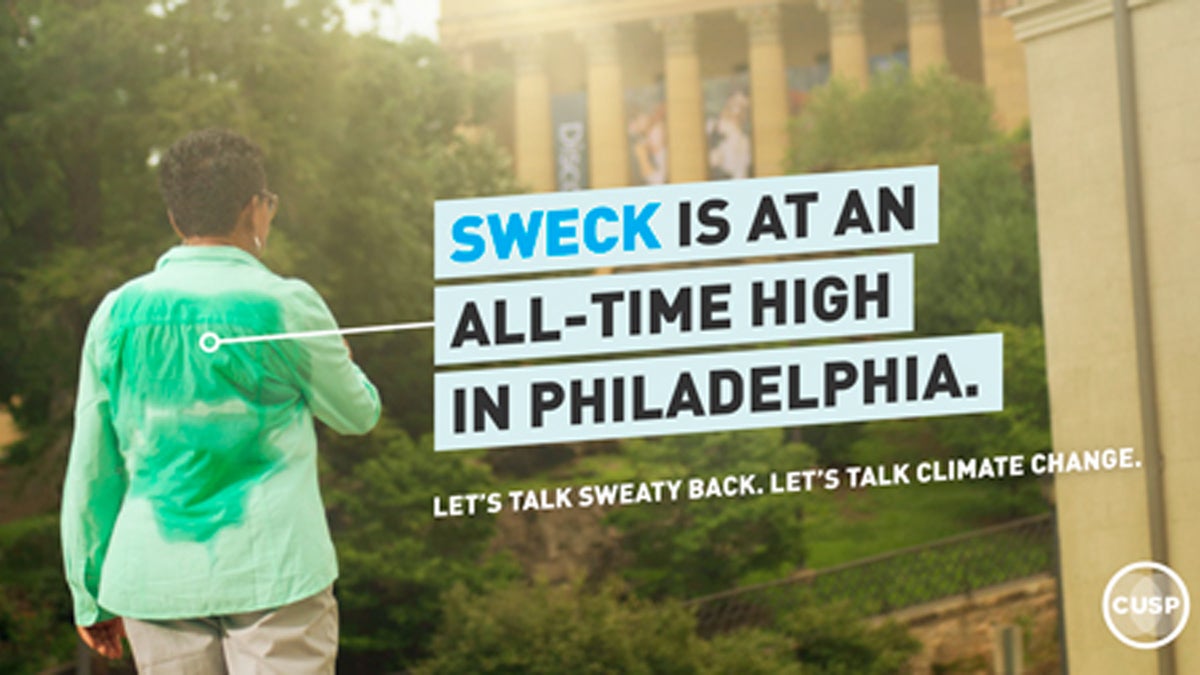Philly groups want your sticky, sweaty selfies

The Climate and Urban Systems Partnership, a coalition of nonprofits, government agencies and educational institutions led by the Franklin Institute, launched the 'swelfie,' or sweaty selfie, campaign to provide local, relevant and solutions-focused information on climate change. (Image courtesy of the Climate and Urban Systems Partnership)
A climate change outreach group in Philadelphia is asking residents to take “sweaty selfies” to raise awareness about the local impacts of climate change.
It’s an attempt to move away from the doom and gloom of traditional climate campaigns and teach people what they can do in their neighborhoods to “live better in a hotter Philadelphia,” organizers said.
About two weeks after the launch of the campaign, there still aren’t many sweaty selfies floating around on the Web.
“I understand. No one wants to have a sweaty selfie posted on Facebook or Instagram,” said Mimi Fuchs from the Franklin Institute, the lead organization in the climate outreach coalition.
“But here’s the deal. A lot of times climate change initiatives are going take a photo of a polar bear on a shrinking ice berg, and it immediately puts people in crisis mode,” said Fuchs, a science interpreter.
Social science research shows that people turn off when they are presented with “big, scary, end-of-the-world imagery,” said the Franklin Institute’s environmental scientist Raluca Ellis.
“So we took a different approach, which is why we’re showing people undergoing a very personal impact,” Ellis said, and adding a funny twist to a serious topic.
The Climate and Urban Systems Partnership, a coalition of nonprofits, government agencies and educational institutions led by the Franklin Institute, launched the “swelfie,” or sweaty selfie, campaign. The group aims to provide local, relevant and solutions-focused information on climate change.
Anthony Leiserowitz, head of the Yale Project on Climate Change Communication, said research shows many people think of climate change as distant in both time and space.
Bringing the global trend down to the local level and describing physical impacts, such as the link between climate change and more intense heat waves, is in step with current thinking on what works in climate change communication.
And the humor of the sweaty selfie campaign, if it strikes the right tone, could help connect with people.
“God knows that this is a topic that needs more humor,” he said.
Recently, Leiserowitz said, more organizations have started to advertise the local impacts of climate change as a way to engage people in a global phenomenon.
The National Park Service, for example, has a Twitter handle dedicated to describing how climate change is causing the glaciers in Alaska to recede and raising questions about the future of the Old Faithful geyser at Yellowstone.
In Philadelphia, organizers hope the “swelfie” movement gains steam as people start spotting ads in Fishtown and SEPTA’s Market-Frankford line depicting sticky hugs, sweaty backs, and men sweltering in drenched suits.
The ads direct people to visit the campaign’s website, which describes ways residents can cope with increasing heat and slow climate change: by getting a rain barrel, planting a tree, riding a bike, or meeting elderly neighbors who may be at risk during heat waves.
This disclosure: WHYY is also a member of the Climate and Urban Systems Partnerships.
WHYY is your source for fact-based, in-depth journalism and information. As a nonprofit organization, we rely on financial support from readers like you. Please give today.

